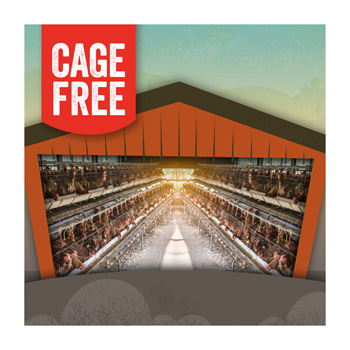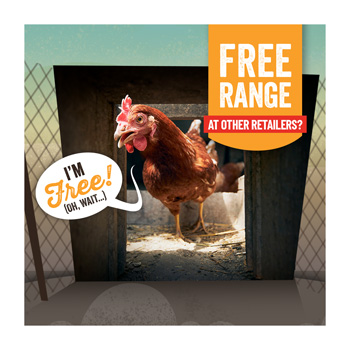


Sign-up for {N}power to get exclusive discounts, newsletters, members-only features, and more!
 Denver - Design District - Alameda and Broadway
Denver - Design District - Alameda and Broadway
368 S Broadway
Denver, CO 80209
United States
 Preferred Store:
Select a Store
Preferred Store:
Select a Store
Eggs and how the hens that lay them are treated is a hot topic right now with multiple states passing laws seemingly aimed at improving the quality of the lives and environments of the hens. Unfortunately, for you, the egg consumer, weeding through which egg is better—for you, the hens, the farmers, and the environment—is a scrambled mess.
We know that you want your eggs to come from hens that are provided with the healthiest and happiest environment possible—who wants to eat an egg from a miserable and miserably treated hen? As the leading family-operated organic and natural grocery retailer in the U.S., we have a MINIMUM standard that surpasses the USDA’s definition of free-range eggs. In fact, we created, what are probably, the highest standards for egg-laying hens around and have partnered with farmers that want to hold themselves to that high standard. We had to set our own standards because the labels on the cartons do not sufficiently address those things that lead to a healthy and happy environment for the hens.
 The gooey labeling mess is a result of labeling claims that imply one thing but, unfortunately, do not necessarily mean what you think they mean— like the term cage free. According to the USDA, “Cage-free eggs must be produced by hens housed in a building, room, or enclosure that allows for unlimited access to food and water and provides the freedom to roam that area during the laying cycle.” This means that the hens do not go outside because if they went outside, they would qualify for the free-range label. The cage-free label only means the hens are not in cages during the laying cycle. Which also means they can be caged when not producing eggs. Additionally, cage free does not cover ecologically thoughtful practices or humane standards of care, such as indoor air quality, ventilation, natural lighting, an environment that promotes natural behaviors and protects the hens, and space requirements per hen in the barn.
The gooey labeling mess is a result of labeling claims that imply one thing but, unfortunately, do not necessarily mean what you think they mean— like the term cage free. According to the USDA, “Cage-free eggs must be produced by hens housed in a building, room, or enclosure that allows for unlimited access to food and water and provides the freedom to roam that area during the laying cycle.” This means that the hens do not go outside because if they went outside, they would qualify for the free-range label. The cage-free label only means the hens are not in cages during the laying cycle. Which also means they can be caged when not producing eggs. Additionally, cage free does not cover ecologically thoughtful practices or humane standards of care, such as indoor air quality, ventilation, natural lighting, an environment that promotes natural behaviors and protects the hens, and space requirements per hen in the barn.
 What about free range?
What about free range?A term that probably conjures images of hens that are out on the “range?” That’s not necessarily the case. The USDA definition of free range says, “Free range eggs must be produced by cage-free hens housed in a building, room, or area that allows for unlimited access to food, water, and continuous access to the outdoors during their laying cycle.” The biggest confusion comes about due to these five words: “continuous access to the outdoors.” This does not mean that the hens are required to go outdoors, it only means that there has to be a small, hen-sized flap somewhere in their indoor area of confinement for the hens to access the outdoors. And outdoors doesn’t mean out on the range, it can simply mean a screened-in enclosure with a concrete floor. Additionally, there does not need to be space for all the hens to be “outdoors” at the same time. Furthermore, the hens could be caged when not laying eggs. Finally, just like with cage free there are no ecologically thoughtful practices or humane standards of care within this definition.

Due to the limited requirements set by the USDA, we saw the need to establish our own standards for egg-laying hens that clearly define what continuous access to the outdoors means, and that includes ecologically thoughtful practices and humane standards of care. We require all of our farmers to go above and beyond the USDA requirements for free range. In addition, we have an egg-ranking system to help you navigate the claims and ensure that you are buying eggs that come from happy, healthy hens and match the standards that you expect. Most retailers are currently struggling to meet a cage-free standard, as evidenced by their failure to meet their self-imposed deadlines for this transition, let alone meet our standard of free range.
We’re really proud to be a leader in the free-range movement because no other major grocery retailer has even come close to our baseline standard. By setting our egg standards high while keeping our prices low and always affordable, we provide you with the ability to buy eggs that are produced with the standards that are important to you.
Take a look at the chart below for a quick overview of what we require, what the label claim requires, and the standards at other retailers.

Click the image to enlarge.
*Egg standards should be clearly communicated by egg suppliers in all marketing materials—including packaging and websites. If this information is lacking, you may not be getting the full story. Ask your retailer for more information.



Sign-up for {N}power to get exclusive discounts, newsletters, members-only features, and more!
